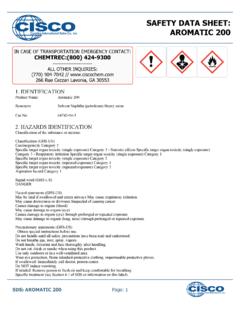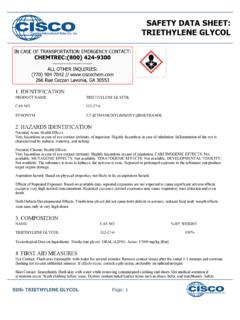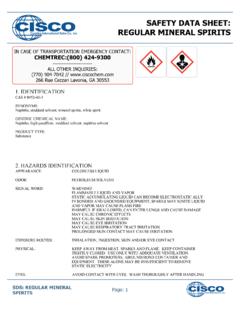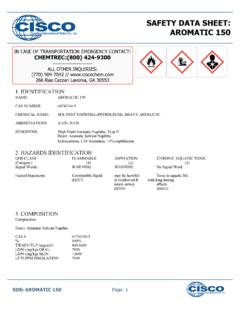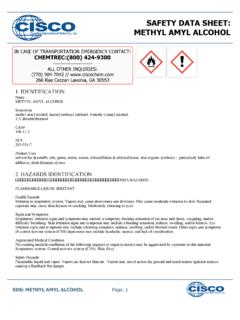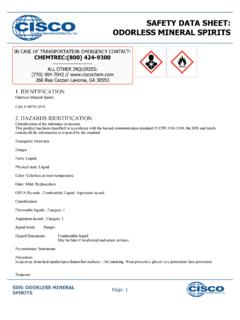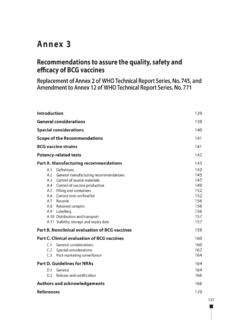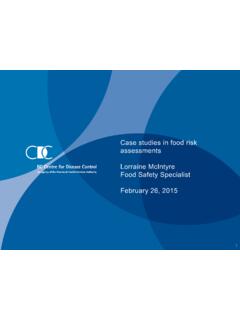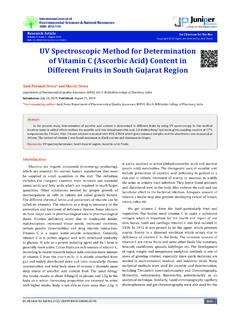Transcription of SAFETY DATA SHEET: TRIETHANOLAMINE
1 SAFETY DATA SHEET: TRIETHANOLAMINE1. IDENTIFICATIONPRODUCT NAME:TRIETHANOLAMINECAS NO:102-71-6 TSA:TSA 8(b) INVENTORY, TRIETHANOLAMINESYNONYMS:Trolamine; Tri(2-hydroxyethyl)amineCHEMICAL NAME:Ethanol, 2,2',2"-nitrilotris-CHEMICAL FORMULA:(HOCH2CH2)3 NMATERIAL USES:INTERMEDIATE, COMPONENT OF A POLYURETHANE SYSTEM2. HAZARDS IDENTIFICATIONP otential Acute Health Effects:Hazardous in case of skin contact (permeator), of eye contact (irritant), of ingestion, of inhalation. Slightly hazardous in case of skincontact (irritant).Potential Chronic Health Effects:CARCINOGENIC EFFECTS: 3 (Not classifiable for human.)
2 By IARC. MUTAGENIC EFFECTS: Mutagenic for mammaliansomatic cells. TERATOGENIC EFFECTS: Not available. DEVELOPMENTAL TOXICITY: Not available. The substance may betoxic to kidneys, liver, skin. Repeated or prolonged exposure to the substance can produce target organs COMPOSITIONCOMPOSITION:NAMECAS NO% BY WEIGHTT riethanolamine102-71-6100 Toxicological Data on Ingredients: TRIETHANOLAMINE : ORAL (LD50): Acute: 2200 mg/kg [Guinea pig]. 5846 mg/kg [Mouse]. 2200mg/kg [Rabbit].4. FIRST AID MEASURESEye Contact:Check for and remove any contact lenses.
3 Immediately flush eyes with running water for at least 15 minutes, keeping eyelids water may be used. Get medical attention. Finish by rinsing thoroughly with running water to avoid a possible Contact:IN CASE OF TRANSPORTATION EMERGENCY CONTACT:CHEMTREC:(800) 424-9300-----------------------ALL OTHER INQUIRIES:(770) 904-7042 // Rue Cezzan Lavonia, GA 30553 Page: 1 SDS: TRIETHANOLAMINEWash with soap and water. Cover the irritated skin with an emollient. Get medical attention if irritation develops. Cold water may Skin Contact:Wash with a disinfectant soap and cover the contaminated skin with an anti-bacterial cream.
4 Seek medical :If inhaled, remove to fresh air. If not breathing, give artificial respiration. If breathing is difficult, give oxygen. Get Inhalation: Not :Do NOT induce vomiting unless directed to do so by medical personnel. Never give anything by mouth to an unconscious tight clothing such as a collar, tie, belt or waistband. Get medical attention if symptoms Ingestion: Not FIRE FIGHTING MEASURESF lammability of the Product: May be combustible at high Temperature: Not Points: CLOSED CUP: C (355 F). OPEN CUP: C ( F) (Cleveland).
5 Flammable Limits: Not of Combustion: These products are carbon oxides (CO, CO2).Fire Hazards in Presence of Various Substances:Slightly flammable to flammable in presence of open flames and sparks, of heat. Non-flammable in presence of Hazards in Presence of Various Substances:Risks of explosion of the product in presence of mechanical impact: Not available. Risks of explosion of the product in presence ofstatic discharge: Not Fighting Media and Instructions:SMALL FIRE: Use DRY chemical powder. LARGE FIRE: Use water spray, fog or foam.
6 Do not use water Remarks on Fire Hazards: Not Remarks on Explosion Hazards: Not ACCIDENTAL RELEASE MEASURESS mall Spill:Dilute with water and mop up, or absorb with an inert dry material and place in an appropriate waste disposal container. If necessary:Neutralize the residue with a dilute solution of acetic acid. Finish cleaning by spreading water on the contaminated surface anddispose of according to local and regional authority Spill:If the product is in its solid form: Use a shovel to put the material into a convenient waste disposal container.
7 If the product is in itsliquid form: Absorb with an inert material and put the spilled material in an appropriate waste disposal. Neutralize the residue with adilute solution of acetic acid. Finish cleaning by spreading water on the contaminated surface and allow to evacuate through thesanitary system. Be careful that the product is not present at a concentration level above TLV. Check TLV on the MSDS and withlocal precautionsNo action shall be taken involving any personal risk or without suitable training. Evacuate surrounding areas.
8 Keep unnecessary andunprotected personnel from entering. Do not touch or walk through spilled material. Avoid breathing vapor or mist. ProvidePage: 2 SDS: TRIETHANOLAMINE adequate ventilation. Wear appropriate respirator when ventilation is inadequate. Put on appropriate personal protective equipment .7. HANDLING AND STORAGEH andlingPut on appropriate personal protective equipment (see Section 8). Eating, drinking and smoking should be prohibited in areas wherethis material is handled, stored and processed. Workers should wash hands and face before eating, drinking and smoking.
9 Removecontaminated clothing and protective equipment before entering eating areas. Do not ingest. Avoid contact with eyes, skin andclothing. Avoid breathing vapor or mist. Keep in the original container or an approved alternative made from a compatible material,kept tightly closed when not in use. Empty containers retain product residue and can be hazardous. Do not reuse in accordance with local regulations. Store in original container protected from direct sunlight in a dry, cool and well-ventilated area, away from incompatible materials (see section 10) and food and drink.
10 Keep container tightly closed and sealed untilready for use. Containers that have been opened must be carefully resealed and kept upright to prevent leakage. Do not store inunlabeled containers. Use appropriate containment to avoid environmental :Keep locked Keep away from heat. Keep away from sources of ignition. Empty containers pose a fire risk, evaporate the residueunder a fume hood. Ground all equipment containing material. Do not ingest. Do not breathe gas/fumes/ vapor/ spray. Wear suitableprotective clothing. In case of insufficient ventilation, wear suitable respiratory equipment.
